In this article, I am going to share with you how you can use B2B SEO Strategy to generate leads and organic traffic for your website, in step-by-step process.
B2B SEO strategy is arguably one of the most famous among digital marketing strategies and you probably heard all the success stories of companies that are generating thousands or even millions of visitors every month.
And not only that but from these visitors’ companies can generate leads for their business.
And according to 57% of B2B marketers say that SEO generates more leads than any of their other marketing initiatives.
So B2B SEO is one of the most important online marketing strategies that your business can implement to drive leads and sales online.
But because SEO strategy is very complex and the competition is getting tougher many B2B companies are hesitating to start with it as they do not know how or from where.
So let me share with you my step-by-step process of doing SEO strategy for B2B companies.
What is B2B SEO?
Business-to-business search engine optimization (B2B SEO) refers to a type of digital marketing strategy used in order to help B2B website pages increase ranking and drive targeted organic traffic from search engines like Google or Bing. B2B SEO marketers are mainly focusing on driving more leads for a business rather than driving organic traffic unlike in B2C SEO.
This means that in B2B SEO you will not be mainly focusing on SEO keywords that drive the most amount of traffic but rather the most number of leads.
Therefore, keyword research is extremely important in B2B SEO as you need to find the right keywords that decision-makers, influencers, and researchers are using to find your solutions.
And this will lead your entire B2B SEO strategy as you need to put yourself in the shoes of your B2B target audience. That is why it is also very important to understand your B2B target audience, you must understand their challenges, pain points, and problems they are facing.
Thus, B2B SEO is not only about understanding search engines and how their algorithms work but also understand your B2B target audience and how they search for your solutions.
And this is what it means B2B SEO, both users and search engines influence your ranking that is why you must understand both search engines and target audience to successfully use B2B SEO for your organization.
If you are new to B2B SEO, then read our article about What is B2B SEO and Why B2b Organizations Need SEO.
B2B SEO Strategy in 8 Steps: Proven Framework
Before we move to the actual steps on how to start with B2B SEO for your business I want to mention that each step and section is a topic itself that you might want to learn to effectively apply B2B SEO strategy, including using it for B2B SaaS lead generation.
I have tried in my best ability to explain and teach you what to do in each step in short, but as you will find out each step could have a more in-depth explanation.
For example, step one is about your target audience and while I tried my best to explain everything you need to know about it to effectively apply the B2B SEO strategy, there is so much more to discuss and learn including aspects like B2B link building and saas link building, there is so much more to discuss and learn.
Therefore I also recommend reading guides to properly understand each step, as each step is the topic itself that requires an in-depth guide to really understand it.
But without further due, let’s get started with step one!
Step #1: Build Your B2B Target Audience
The first step to start effectively with a B2B SEO strategy is to know who you want to attract to your website. This is important to ensure you are driving the right traffic so you can convert it into leads for your business.
Therefore, let’s first start with how to research your B2B Target Audience.
To effectively determine your target audience, you first must understand your products or services you are offering. This is step 1 of identifying your B2B target audience.
So, look at your products and/or services and think who could benefit the most from your solutions, who are the people and companies that will be using and benefiting from your products or services.
For example:
If you own a product like SEMrush that is helping with SEO, content marketing, competitor research, PPC, and other aspects of B2B digital marketing, you might be focusing on brands looking to improve their digital marketing such as SEO or PPC.

But not only that, but you might be also focusing on specific industry and size of the brand, while a product like SEMrush can be rather used by anyone, it does not always apply to B2B companies.
Therefore, determining the right industry and size of the company is very important for B2B organizations as well. Because you do not want to attract companies that can’t afford or have no need for your products or services.
To summarize it:
Step #1: Find the benefits of your products or services
Step #2: Come up with brands that will benefit the most from your products or services
Step #3: Narrow down the list by demographics, such as industry, size, yearly revenue, etc. that are most likely to buy from you. TIP: if you already have customers, make a list and look at what they have in common, and start with that.
Step #4: Write down your B2B target audience. E.g. Companies in Service, Retail, and Manufacturing Industry, with 50+ employees and $10 million annual revenue.
And there you have your target audience, now let’s move to the actual people or your personas.
Build Your Decision Maker Persona
Once you have your B2B target audience then you must create your B2B buyer personas. These are the actual and ideal people in the company who will be deciding whether to buy your solutions or not.
To build your personas you first need to know the 3 important types of personas:
- Decision-Maker: is the person who has the purchasing power and signs the contract. Typically, these are the high-level management like C-levels, VP, and Directors.
- Influencer: Is the person in charge of searching for the solution and in charge of the department that will be using the solution. And while this person has no authority to sign the contract he can strongly influence what solution to choose. Typically, these are in the management positions like managers and senior managers.
- Researcher: The last person is the one who will be doing actual research and finding a potential solution to solve the problem the company is facing. Typically these people are one of the 2 previous personas or it can be the actual users of the solution like Admins, Finance executive, or Marketing executives.
What you also need to know that these roles can be combined and one person can be an influencer and research at the same time or the decision-maker is also a researcher. This is a good thing because it gives you space to produce content for multiple personas.
So to create your personas first you must understand your target audience, if it is a large corporation, then probably there will be multiple roles involve, or if it is smaller businesses then fewer people will be involved in the purchasing decision.
For creating your personas you can use tools like Xtensio, just select what template you want to create, in this case, User Personas.
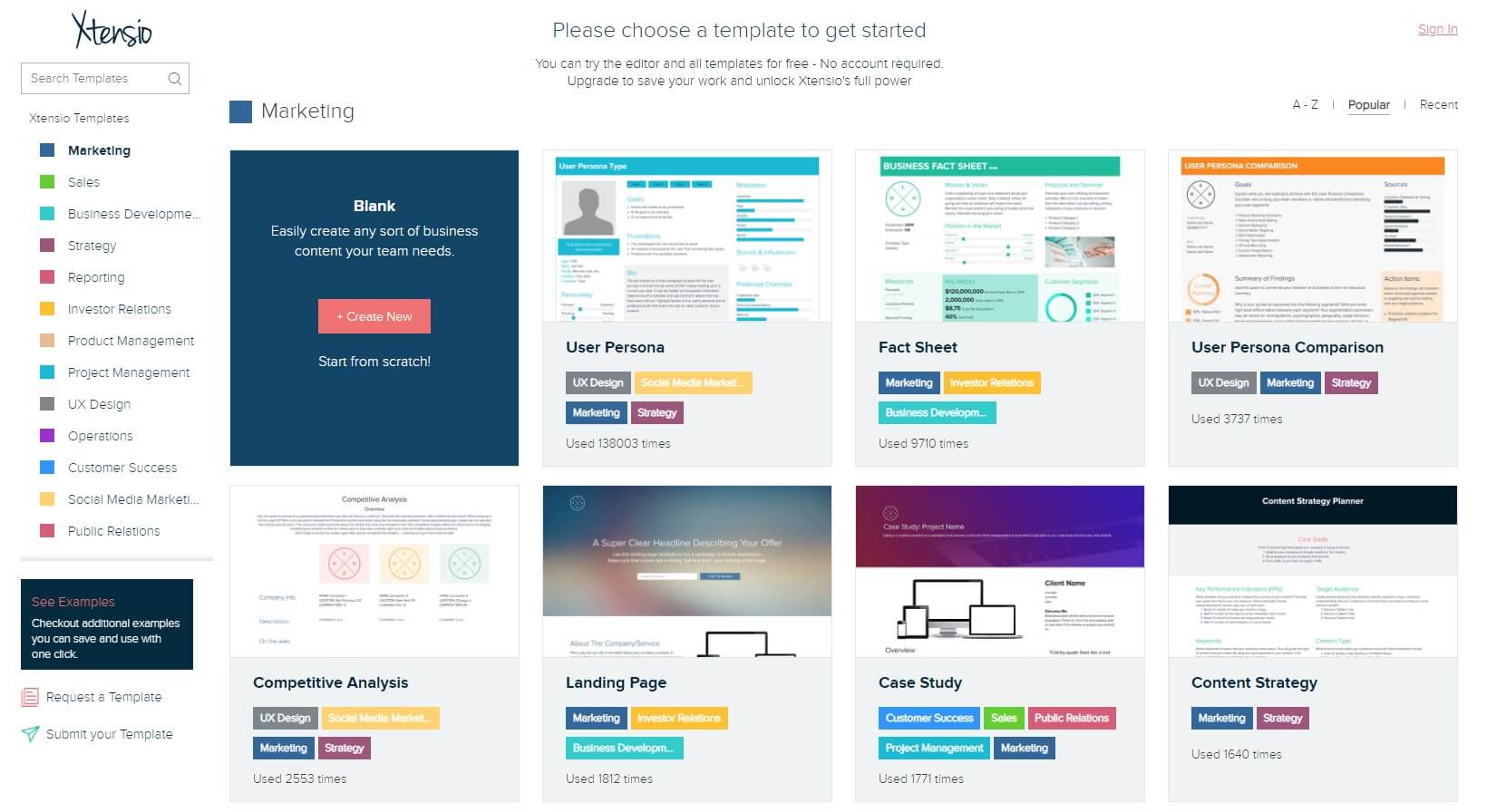
And here you can fill up all the information you need to create your first B2B buyer personas. I definitely recommend starting with at least 3-5 different personas, so you have a clear picture of who you are targeting.

Remember, that you want to focus on the most important points such as department and position, also include the industry and size of the company of the person that will be searching and buying your solution.
To learn more read my guide on how to create your personas.
Step #2: Find Your Keywords
The second step is to find the keywords your personas are using to find your products and services. This step is super important because the keywords you will be targeting will determine the success of your B2B SEO strategy and it’s the essential part of SEO pyramid.
Because if you target the wrong keywords for example:
- Do not have any potential to drive website traffic.
- Are too hard to compete.
- Keywords that bring different target audiences and not yours.
Then your B2B SEO strategy will not be effective, and you would waste so much time, effort, and resources on targeting wrong keywords, therefore pay close attention to the keyword research.
To effectively do B2B keyword research, you must understand the b2b buyer journey and then find your keywords for each stage of the buyer journey.
B2B Buyer Journey
B2B Buyer Journey is getting more complicated due to the vast amount of information available online. According to Accenture, most B2B buyers are already 57% of the way through the buying process before the first meeting with a representative.
B2B buyers are doing research online about how to solve problems, what solution can help them, and what product or service is the right for their needs. This means that if you want to drive new leads for your business you must be online.
And to effectively attract your potential prospects, you must know what and how they search online. That is why the B2B buyer journey is so important.
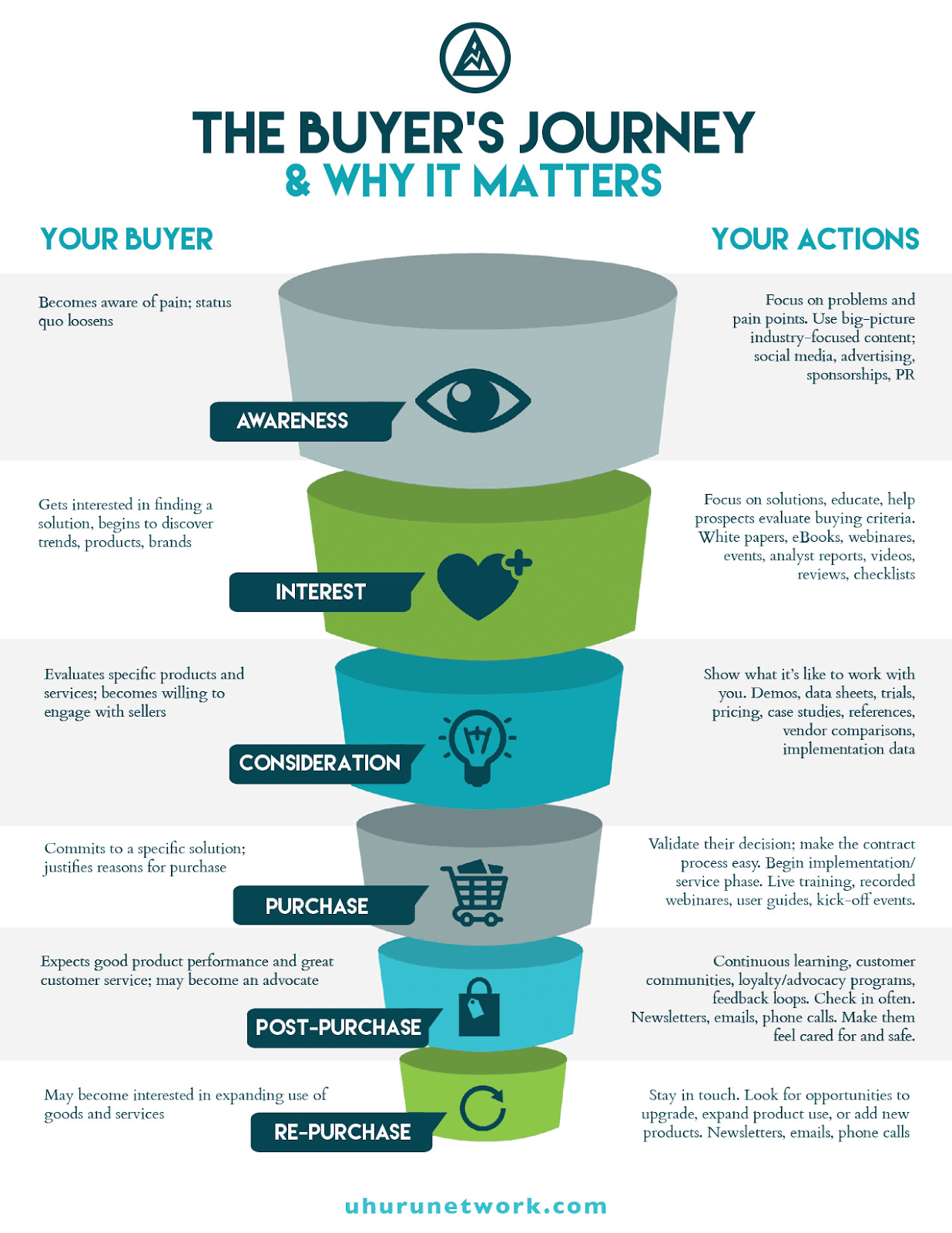
Therefore, by using buyer journey you can find the right keywords you should target to effectively attract your target audience at each stage. So, let’s look at each stage and how you can attract your B2B buyers.
Keywords for Awareness Stage
At the awareness stage, you want to focus on the problems and pain points that your solution is solving. Also, you want to focus on topics your target customers search for. If you do not know the problems and pains your solutions are solving, then you can ask sales or your customers or you can Google it, probably there are similar solutions out there.
So, once you know what problems and pain point your solution is solving, then you can start searching for keywords your prospects might be using to find a solution for that problems.
For example:
You are selling all-in-one marketing solutions for medium and large size businesses and one of the pains and problems your solution is solving are disconnected systems, not fully integrated, manual data duplication, and missing data.
So here you focus on keywords like:
- How to Connect Multiple Marketing Tools Together
- How to choose marketing solution for medium-sized businesses
- How to Improve Marketing productivity
- How to remove manual data duplication
All these are topics and keywords you can target for this scenario, and as you can see these are mostly how-tos because people are searching for specific solutions.
But on top of that, you can target keywords that your buyers are searching for but have not much to do with your solution. For example, in this scenario, b2b buyers are probably marketers and those can search for other marketing articles.
And by targeting keywords around marketing, you can still drive your B2B buyers because it doesn’t mean that if they do not search for a solution they do not experience the same problems. It can mean they are not aware of that or don’t have time. Literally in the awareness stage sky is limit as long as you fit your market.
So, if your products or services are related to finance, then focusing on finance related articles is close enough to drive your b2b buyers in the awareness stage.
But as I said I would first start with keywords related to the specific pains and needs your product is solving and later you can expand.
Keywords for Interest Stage
At the interest stage, prospects already have enough information to know what to do and how to solve their problems. Now they will be researching the market and what potential solutions are out there.
At this stage, you want to focus on your solution and educate your b2b buyers on what is important and what is not. Here you are gaining certain power to influence and direct them towards your products or services.
Here you must understand what makes your products or services different and better from your competitors and use this knowledge to influence your B2B buyers.
Let’s use the same example.
So, you are selling an all-in-one marketing solution and you know that your landing page feature is one of the most advanced and your tracking feature across channels is unique against your competitors.
Based on that you can know that companies that use a lot of landing pages and particularly care about tracking customer interactions are most likely to search for it and makes them potential customers.
Therefore, you should start target keywords around those topics, but also target keywords that are closely related to your solutions and features you provide.
And to find them, you can use keyword Magic Tool from SEMrush, that will help you to find all kind of related keywords based on topic or feature itself. Like the keyword “landing page” which is one of the features.
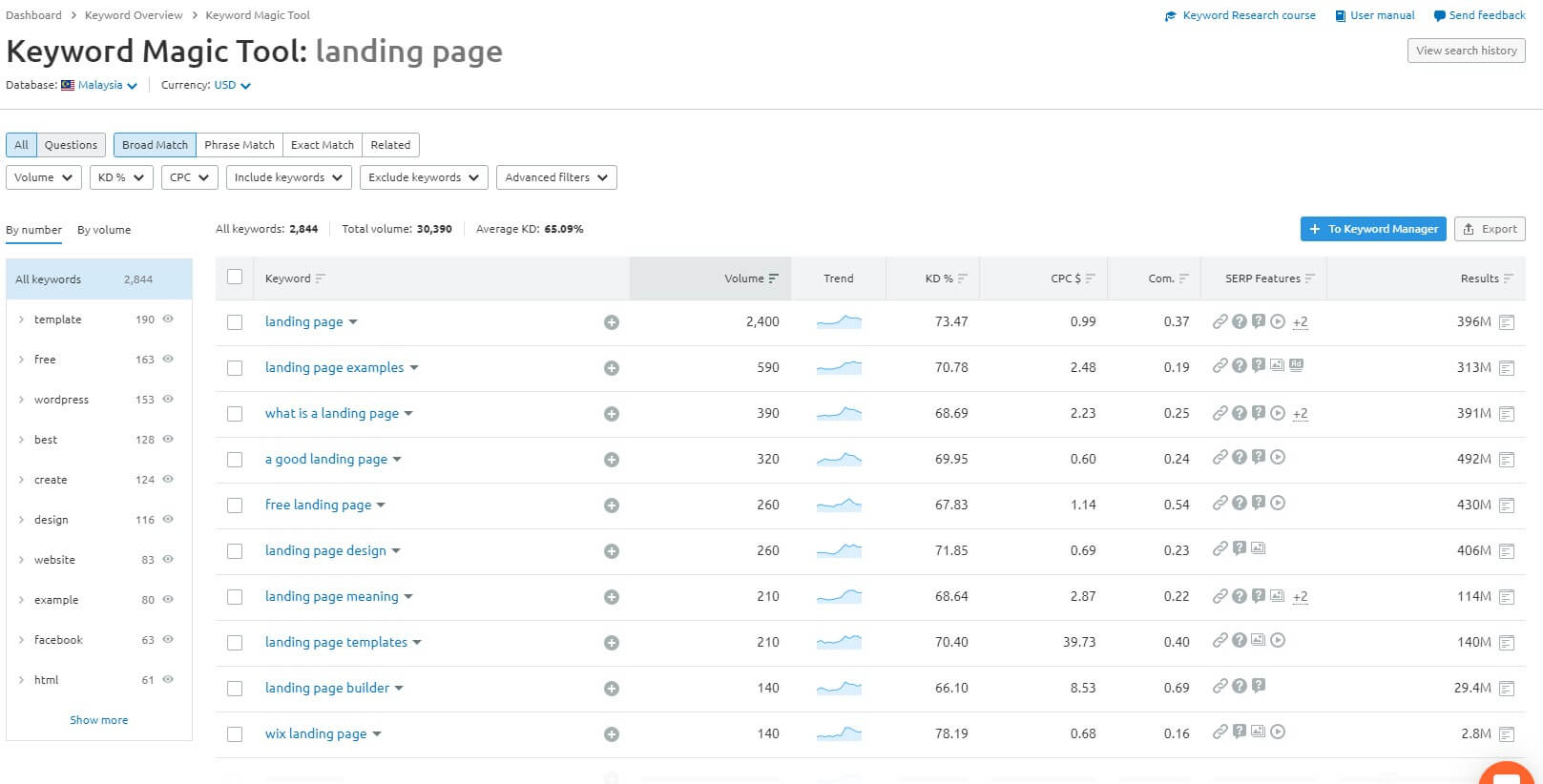
Keywords for Consideration Stage
At the consideration stage, your prospects already have a good amount of information about the market, what solutions are out there and what features are typically provided by them,
Here your B2B buyers are typically willing to engage with your sales team, but there are still some keywords you can target.
Typically, at this stage, your buyers are comparing vendors and that is what you should do. Keywords like Solution A VS Solution B and why Solution A is better than Solution B are perfect to start driving marketing qualify leads.
At this stage, your keywords are heavily based on the features and benefits of your products or services and what makes you unique and better than your competitors.
For example:
If your all-in-one-marketing solution provides a better landing page feature, then you should target a keyword You VS Competitor A and show how important is to have a landing page to improve marketing results.
Remember at this stage, the content is more selling rather than educational, yet educational enough that you teach your buyers to make the right decision.
Step #3: Build Your Products and Service Pages [SEO Friendly]
The third step is to build your products and service pages or if you already have one, then optimize them with SEO.
One of the biggest mistakes you can make is to build your products and services pages without a targeted keyword. Every page on your website should have a prior keyword, like this, you can ensure that you do not do any keyword cannibalization.
And these pages should have keywords that you have found within the interest and consideration stage. These are the bottom of the SEO funnel keywords that will drive prospects at that stage.
For example:
If you are selling the all-in-one marketing solution, then your product page keyword should be reflecting that, such as an all-in-one marketing solution or just a marketing solution.
Also, what is worth mentioning is that often you might have just one product like for example GetResponse, which is their one product, but because they have so many different features within the product, then they have different pricing packages, and depending on the package you choose you get the features.
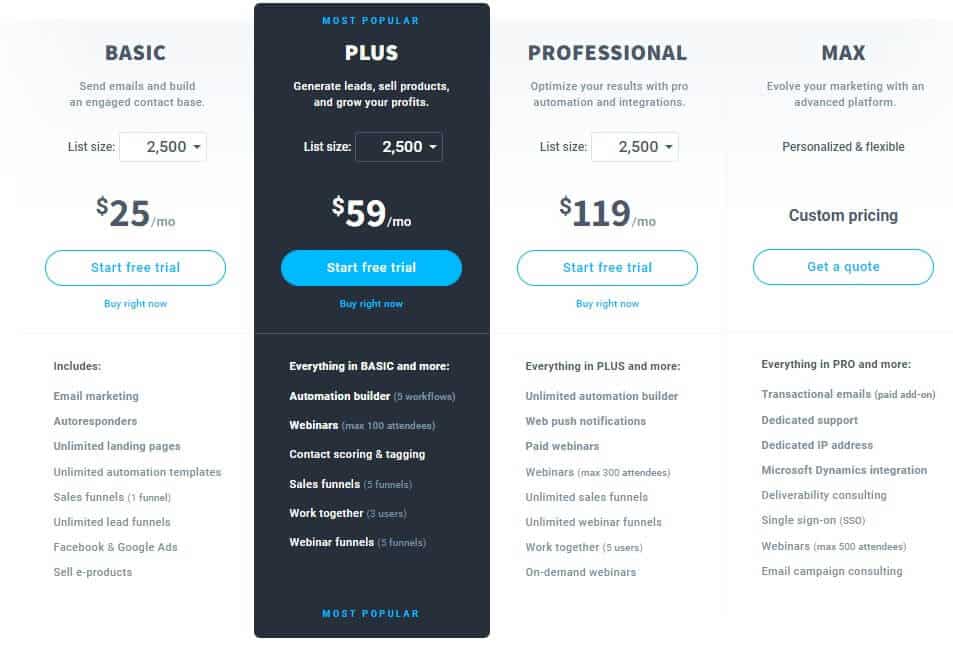
So in this case you optimize your homepage for the number one bottom of the funnel keyword you want to target, which for GetResponse could be an inbound marketing solution or around this sense.
And because keyword like inbound marketing solution is broad, then you create your solution pages.

Also, create your feature pages and target those keywords that are related to the feature.
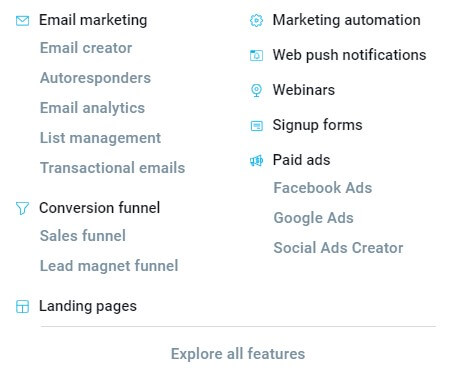
For example:
Within the GetResponse solutions menu, you can see “Generate Leads” and when you click on it, you will see that their targeted keyword is lead generation software or lead generation solution.
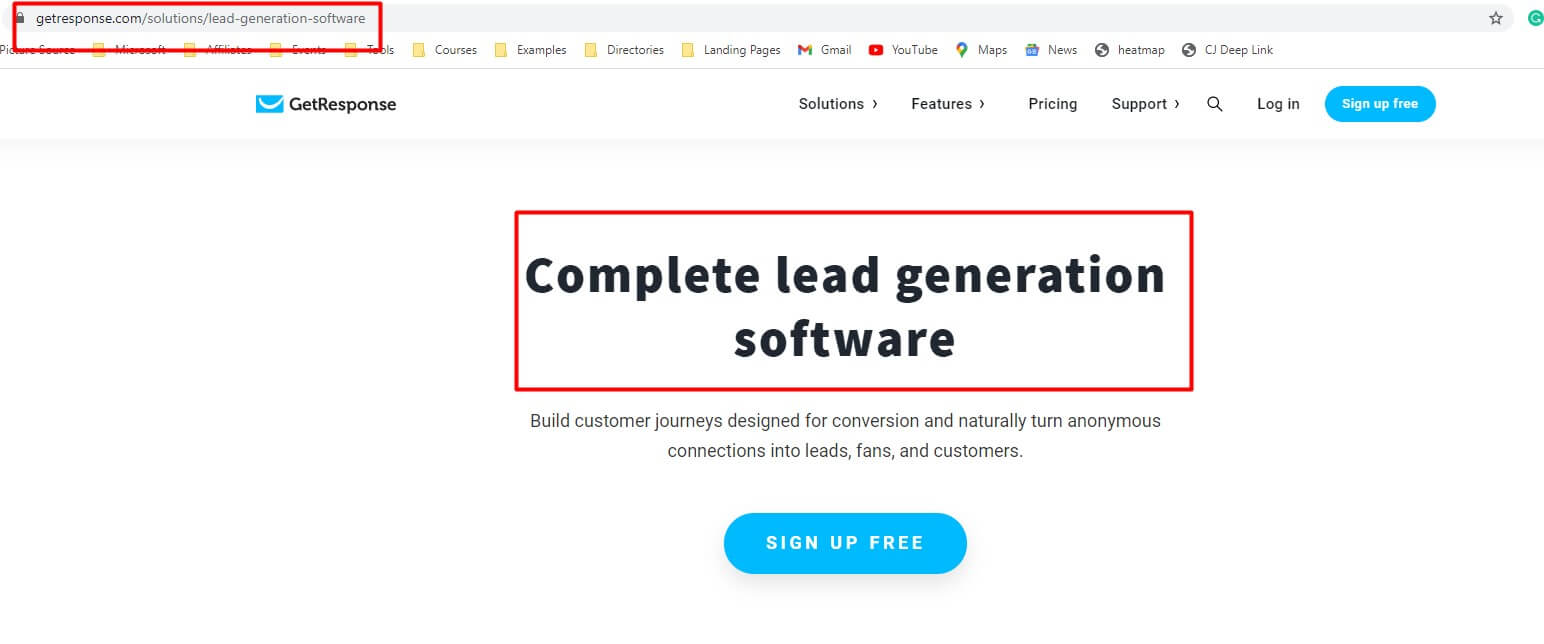
Like this, they can ensure they can rank for one of their interest and consideration stage keywords that is related to their product. Therefore, they can drive organic traffic that is searching for their solutions.
Another example is the GetResponse Webinar feature, as their product includes this feature.

So, with pages like this, they can target multiple profitable keywords to drive organic traffic and leads that are researching and finding the solutions and features they provide.
And because b2b buyers who are searching for these keywords are in the market for the solution you can drive a lot of leads for your business.
Of course, it is very important to ensure that you have the features, and your product works as the solution for certain needs. If your product does not help with lead generation, then you should not target keyword lead generation software.
Alright, once you have the bottom of funnel keywords you want to target with your products/solutions/features and service pages, then create those pages and optimize them with B2B on-page SEO strategies such as include the keywords in:
- Pictures name and alt-text
- H1 tag
- Meta-description
- Title Tag
- Body of your text
And there is so much more so I recommend once you creating your product pages, then follow some B2B on-page SEO checklist. Also, check out our handy On-Page SEO vs Off-Page SEO Infographic.
Step #4:Build Your Landing Pages [SEO Friendly]
The fourth step is to build your landing pages. According to HubSpot the number of landing pages on your website directly influences your lead generation. Therefore, if you are serious about getting leads from your website, then you need to create more landing pages.
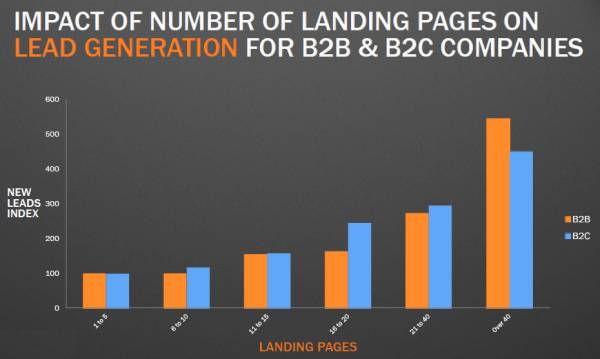
This means that from wherever you want to drive leads you must create a landing page.
So how can you start with creating landing pages?
First what you need to know is that you must match your landing page with the call to action you have on your page.
For example:
GetResponse is using call-to-action “sign up free”.
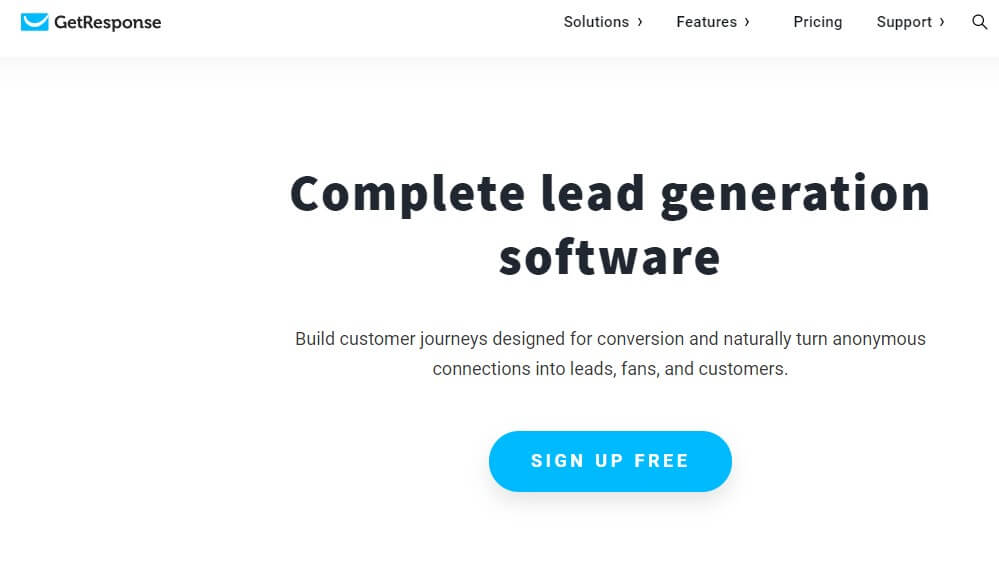
And when you click on the CTA, then it will redirect you to the landing page where you can sign up for a free trial.
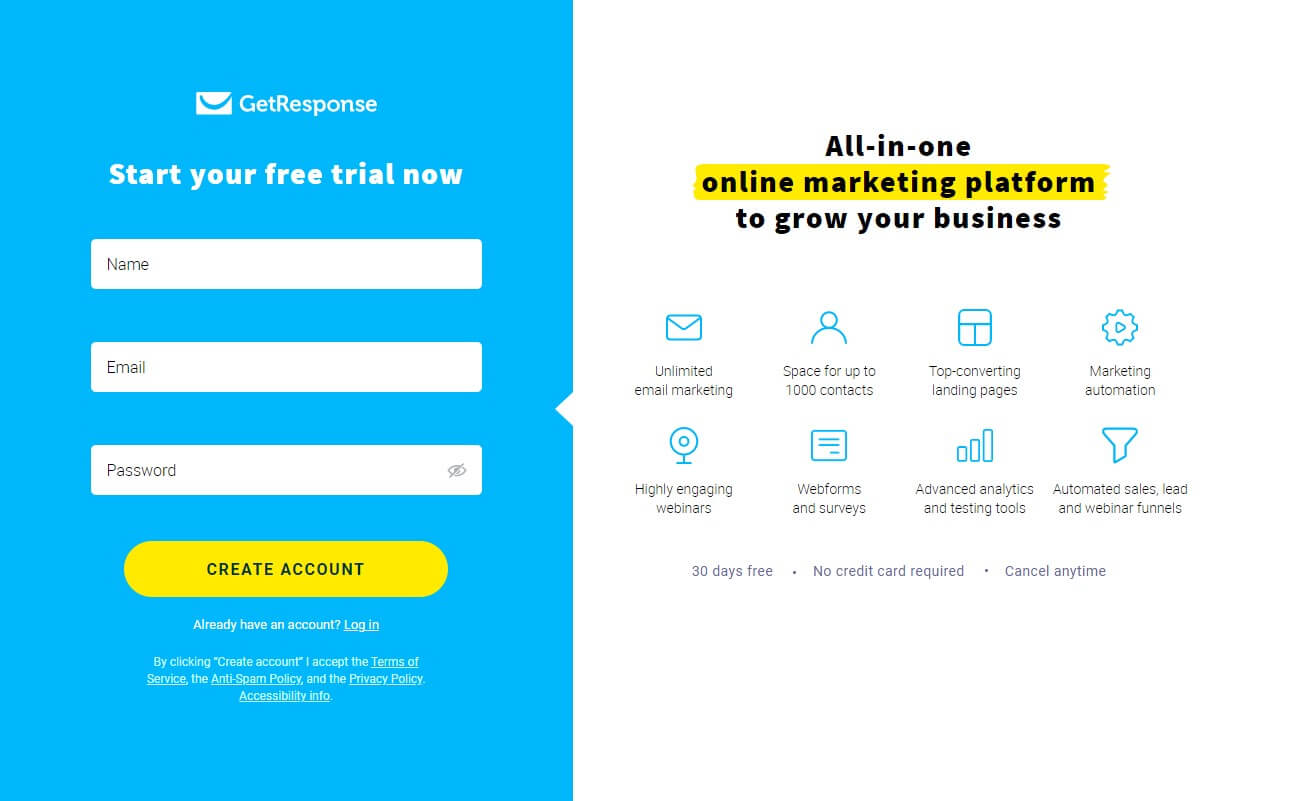
In my opinion, this landing page does not exactly match the CTA “Sign Up Free” as CTA such as “Start Free Trial” or Sign Up Free Trial” would be more matching to the landing page. This landing page could potentially hurt your conversion rate and your brand reputation as somebody could get upset with misleading messaging.
In another example:
You can create a landing page for your ebooks. HubSpot is doing a great job in creating landing pages for every single downloadable content they produce.

Typically, they promote related content upgrade on their blog posts, this allows them to capture leads in the early stage. Of course, they match the CTA with the landing page to boost their conversion rate.
TIP: To generate a lot of leads from your blog posts you should create content upgrades for your blog posts.
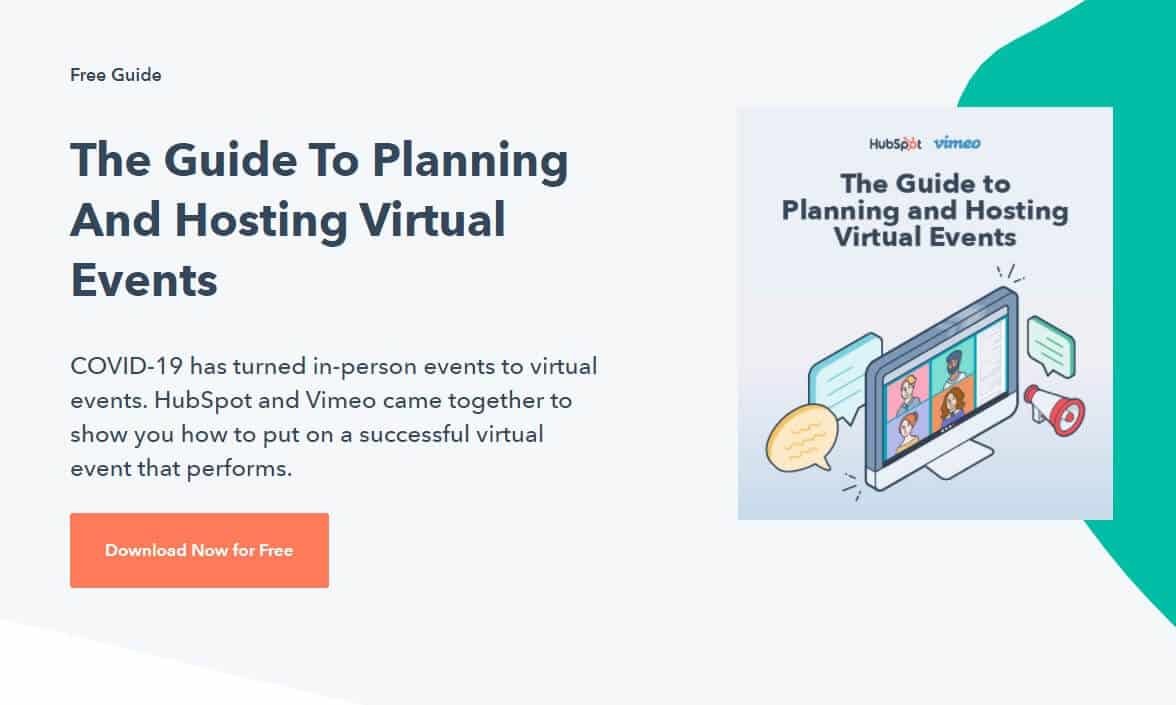
And not only that but HubSpot went even further and build their thank you page as a landing page. They create even a specific thank you page for each of their downloadable content to get people to sign up for their free entry-level marketing and CRM system.

Literally, with landing pages, you can get creative and think of different ways to generate leads for your business or when you are selling leads.
And there are many different types of landing pages you can create such as landing pages for:
- eBooks, whitepapers, guides, and other downloadable content
- Demo Request or consultation request
- Pricing or Quote request
- Free trial or sign up
- Newsletter sign up
Just look around your niche and what landing pages your competitors are creating. But do not worry to get creative, as the more you try and test, the more data you will have to understand what is working for you and what’s not.
Also, remember that the more personalized the landing pages you can get, the better conversion rate you can expect from them.
In the example of GetResponse CTA and landing page, I would create something more related to the actual product/solution page and the actual CTA.
Such as a landing page that will be focusing on the Free 30 days Trial to their Landing Page feature and mention other features that come with the free trial. Like this, you match what the user wanted to sign up for and also throw extra features that will come with it. Also check out my best landing page tips.
Step #5: Start with Content Creation
The fifth step of the B2B SEO strategy is to start producing content on your website to generate relevant organic traffic. Here is where your keyword research plays a vital role because you want to target the right keywords to attract the right people to your website.
Because Quality content optimized with SEO is the key factor in any good SEO strategy. Improvements in the content have been known to increase website traffic by as much as 2,000% and 72% of marketers say the single most effective SEO tactic is creating relevant content.
To be honest, most of your B2B SEO work will be dedicated to creating and optimizing your content on your website.
And there are different types of content you can create to start generating organic traffic and leads for your business. But I will mention only the two single most important B2B Content Marketing strategies that are tight up to B2B SEO strategy and are focusing on generating relevant organic traffic.
Also, later I will describe other B2B content marketing strategies that are super important for your B2B SEO. But for now, let’s check the two strategies you should focus on first.
B2B Blog
Starting with blogging is one of the most important and effective strategies to boost your B2B SEO strategy.
Marketers who prioritize B2B blogging are 13x more likely to have a positive ROI on their efforts and B2B marketers who have blogs get 67% more leads than those who don’t.
But you cannot just start with blogging, as there is a ton of competition and you need to go smart about it. The first thing you need to know is that you need to create extremely valuable content for your target audience.
And that is where most B2B companies get it wrong, as they create blog posts mostly about themselves. Like for example, 10 reasons why my product is the best or everything you need to know about my product.
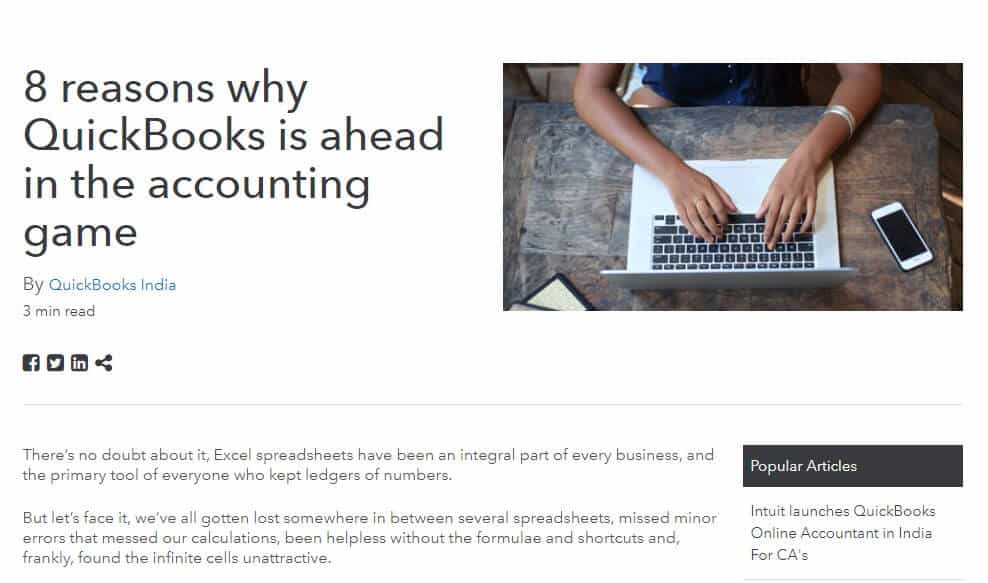
And while it is not totally wrong, it is most likely that this piece of content will not attract your target audience because barely anybody will search for this.
I mean think about it, if you have a problem, you will not search for a company product name you don’t even know about that solve your problem, right?
That is why, I said, that you must create content your B2B target audience is looking for and if you have done your keyword research correctly you should have plenty of topics and keywords to start with writing articles.
Video Production
Creating videos for your company has numerous benefits like increase conversion rate, brand awareness, and more.
For example, posting videos on YouTube helps you to increase your organic reach as YouTube is the second largest search engine right after Google. People are using YouTube the same way as Google to find information and learn new things.
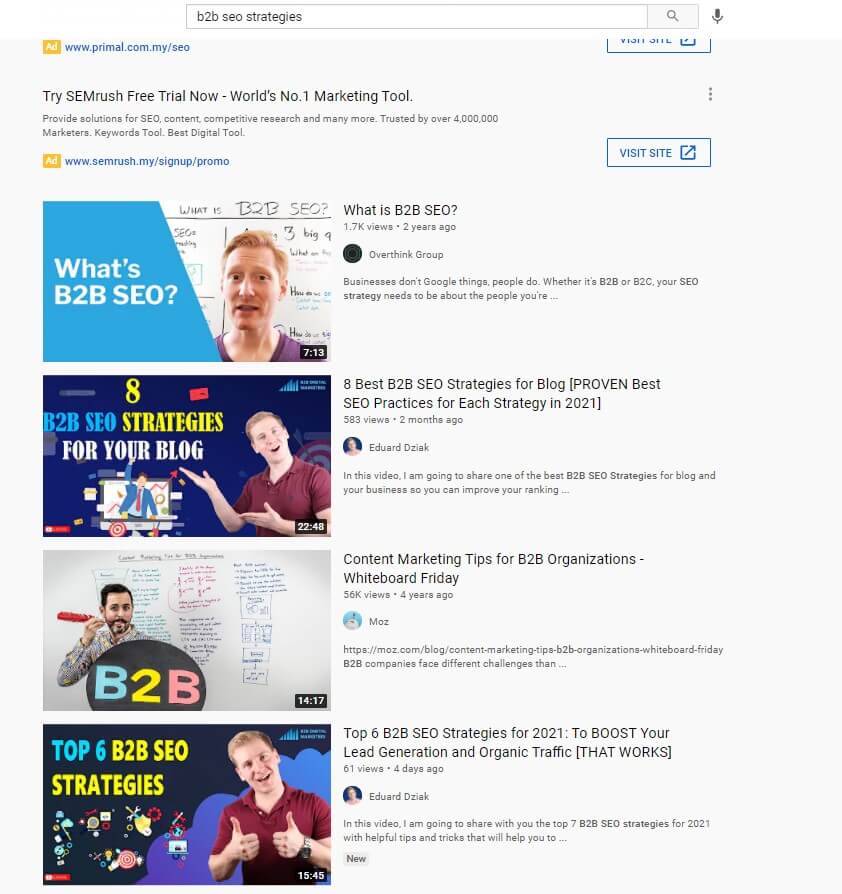
The power of videos especially on the YT is that 90% of people who are watching your videos never heard about you because YouTube is doing a great job at suggesting new videos for you to watch that are relevant to your interest.
This means it is a great asset for your company to be discovered and build brand awareness.
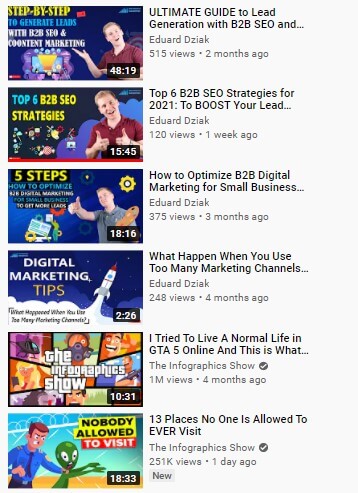
In today’s world, people spend more time watching videos than reading, according to YouTube, users view more than 1 billion hours of video each day on YouTube, and also 59% of executives say they would rather watch a video than reading text.
Because people are more visual creatures, your brain can process visuals much quicker than it can text. About 90% of the total information transmitted to your brain is visual. On top of that, your brain can process these visuals 60,000 times faster than text.
And they are easier to make than you think, especially if you are already writing blog posts, because then you can repurpose that blog post into video and use the blog post as your script, like this, you maximize your effort of going about content creation and maximize your opportunities.
Videos are the future there is no doubt about it and you should definitely include it within your content and SEO strategy plan to boost your organic reach and drive more leads for your business.
Step #6: Build Authoritativeness for Your Website
The next step to build an effective B2B SEO strategy is to start with building authoritativeness for your website and your brand with link building strategies and tiered link building.
The thing is about getting a higher ranking on search engines like Google is not only about producing great quality content and wait to appear on the number one position in search results, and I have learned that the hard way.
So, if you are serious about your B2B SEO strategy and you want to start ranking high and driving a ton of organic traffic and SEO leads for your company, then you need to build your online authority because, without it, you can keep posting but see no results.
And one of the few ways of building high authority for your website is to get backlinks from another high authority website that are relevant to your industry as stated by Google:
“We look for sites that many users seem to value for similar queries. For example, if other prominent websites link to the page (what is known as PageRank), that has proven to be a good sign that the information is well trusted.”

Therefore building links to your website is very important to build trust with search engines and your users and get a higher ranking, so let’s look at some of the effective strategies to build backlinks for your website.
Promote to Get Backlinks
If you are producing great quality content, then one of the ways to get backlinks is to drive eyeballs to your content so people can link to your awesome quality content.
But because a search engine will not drive any traffic to your article, not at least for now, you have to promote your content so people can see it and link to it.
Honestly, this is very tedious work, and it can take a lot of your time, for example, Brian Dean from Backlinko, spent almost 80% of his time promoting his articles to get the attention he needed to get backlinks. This method takes a lot of time, especially if you do not have a following yet.
So, I recommend you get help from freelancers on Fiverr or anywhere else to help you with promoting your new articles.
And some of the ways to promote your articles are:
- Share your articles with those you have linked to
- Put it on forums and social media
- Create snippets and share them on social media
- Share with your email list (if you have)
While this strategy takes time, is also one of the easiest to do, it just requires a lot of patience. It is like a numbers game, you can expect typically between 0.5% to 1% success rate.
PR Outreach
Another strategy is PR outreach, where you are searching for a blogger or journalist to promote your products or services.
This typically works very well if you have something unusual or trendy. Otherwise, you can spend quite a bit of time on this strategy and get minimum results.
Honestly, I am not an expert on PR outreach so I will not give you many tips on this, I just wanted to mention this B2B SEO strategy to get backlinks.
But I have read a few PR outreach blocks, and I would definitely recommend you to read the PR Outreach guide from Ivan Escott where he goes into details about PR outreach. So I recommend you to read his guide to learn more about it.
Related: Blogger Outreach: The Right and Not Spammy Way
Related: Press Release SEO for Link Building
Guest Blogging and Podcast
Another B2B SEO strategy to get backlinks and increase your online authority is to start with guest blogging and appearing on podcasts for backlinks.
This is one of my favorite B2B SEO techniques to get high-quality backlinks for a website. Yes, it requires extra work, but the results are worthy.
And a great example is the BufferApp that used a guest blogging strategy to acquire over 100,000 customers within just 9 months.
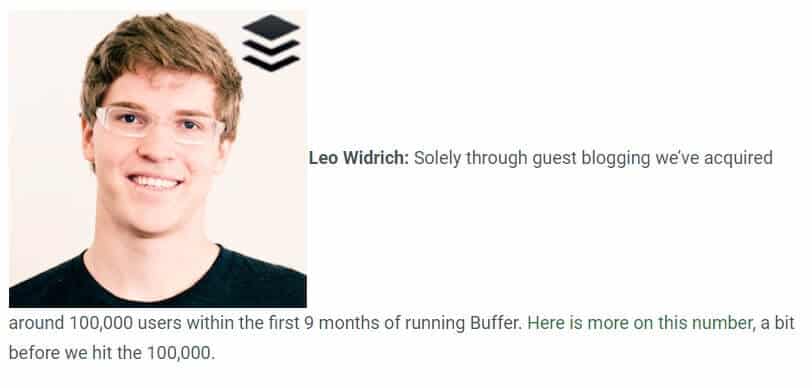
(source)
This is an SEO strategy that I recommend to almost everyone to start with as you can build backlinks from high authority websites by sharing your expertise and knowledge.
Also, you can hire a freelancer on Fiverr to help you find guest blogging and podcast opportunities. Simply write 10-15 topic ideas and then give them to the freelancer and let him find opportunities for you.
Of course, this SEO strategy has its downside, as you must be really good at what you are doing because nowadays there is a lot of competition and every blog, magazine, or website with a high domain rating gets a lot of offers for guest blogging.
Create Partners Section
The last B2B SEO strategy to build authority and backlinks for your website is to create a Partners section on your website and on the websites of your partners.

This is probably the easiest and best way to get backlinks to your website, as you can create a partners section and link to each other website to get valuable links.
Of course, this depends on the partner authority website, but it won’t hurt to have this section and get an extra link or two and help each other.
Therefore, if you are having business partners, just talk to them and offer to help each other.
Remember, link building benefits are enormous and if you want to rank, you need to build high-quality backlinks.
Also make sure you effectively track your backlinks so you can preserve them as long as possible.
Step #7: Build Social Media Presence
The seventh step to a successful B2B SEO strategy is to create social media.
According to Cognitive SEO research, a strong presence on social networks is correlated with better rankings.
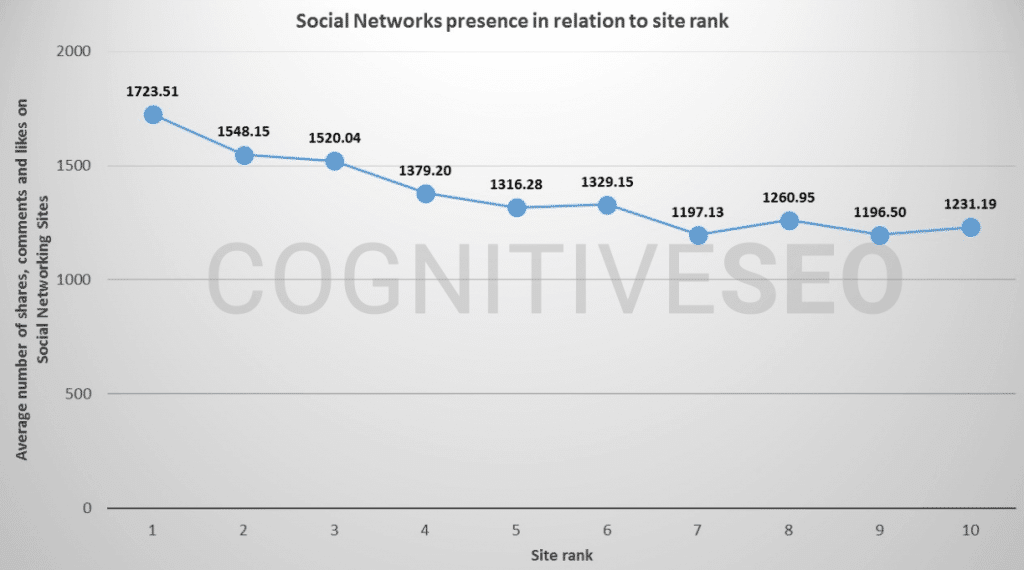
And while SEO’s could argue that social media does not have direct impacts on your SEO strategy and ranking, but when more people share your content on social media, it generates social signals that indicate your posts are being helpful and valuable to your target audience.
Also at Pubcon Pro 2017, Gary Illyes confirmed that Google might use online mentions of a brand and as stated by Gary:
“The context in which you engage online, and how people talk about you online, actually can impact what you rank for.”
This clearly shows that social media can influence your B2B SEO strategy. It is obvious that Google is looking at social media and how people engage with your content and brand.
But of course not only that but social media also indirectly influence your B2B search engine optimization strategy as you can drive referral traffic from social media and the way how your users interact with your website can influence your SEO results as well.
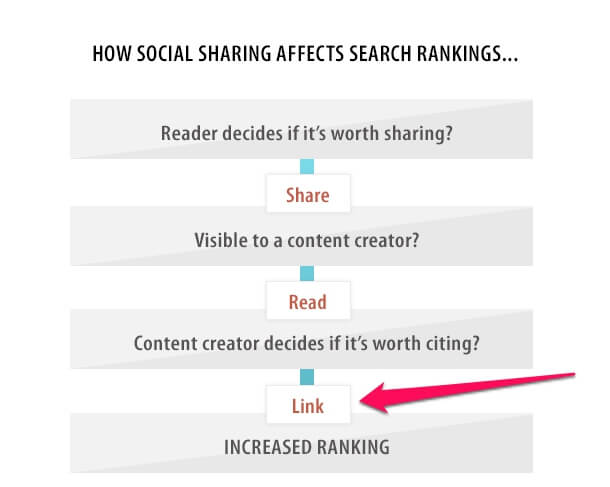
So even though social media is not a super strong ranking factor, you should be building a robust social media presence not only because of SEO but because social media are great for B2B lead generation and increase brand awareness with a small budget and commitment.
Step #8: Regularly Conduct B2B SEO Audit
The last step of your B2B SEO strategy is to regularly conduct a B2B SEO audit to ensure your website is without serious mistakes.
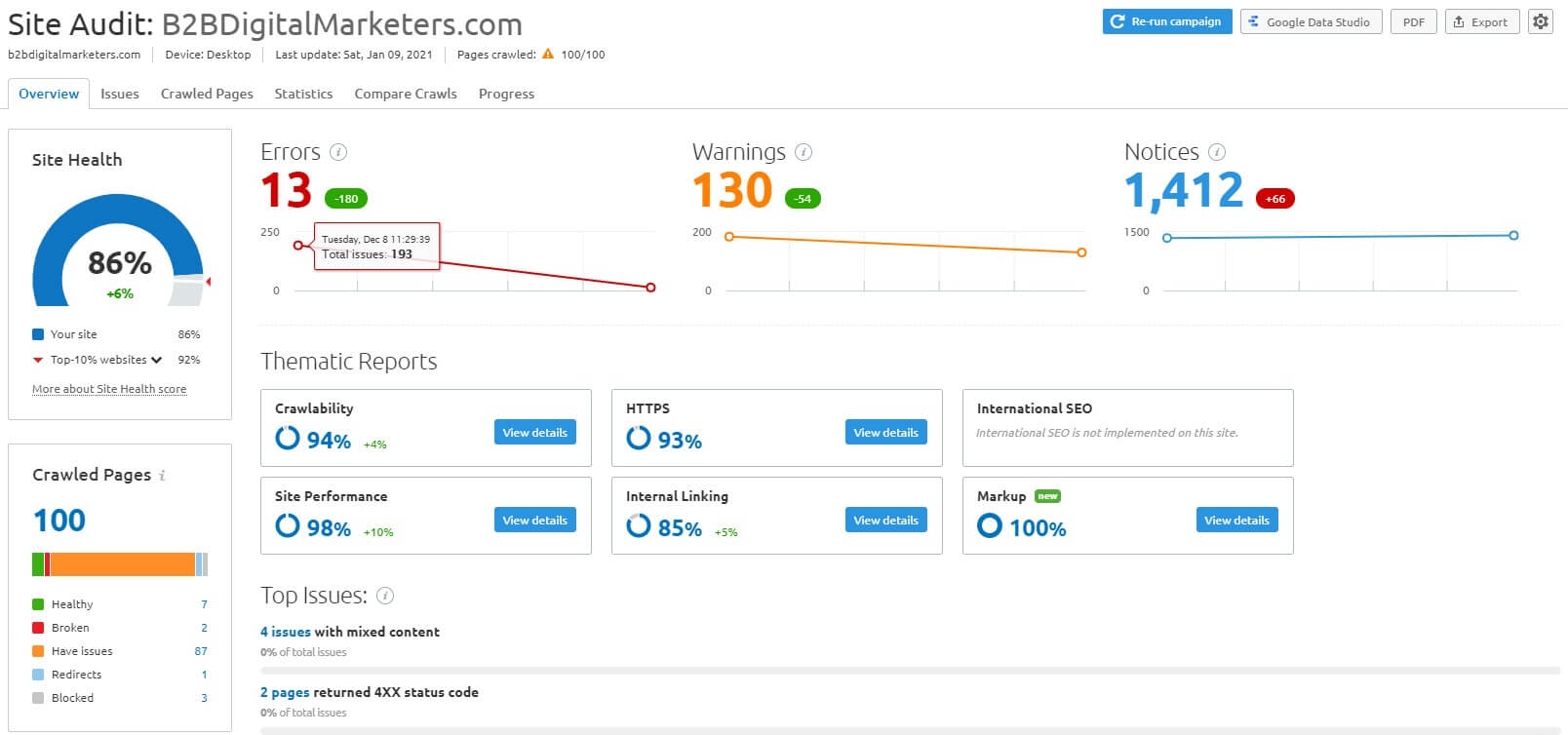
Along the way when you are adding new pages, deleting old ones, and do updates on your website something can go wrong, which is absolutely normal.
But it doesn’t mean that you should just let it go. Regular SEO audits are important so you do not harm your website ranking and you can make sure that you provide the best user experience.
Luckily doing an SEO audit is easier than you might think as there is plenty of B2B SEO tools you can use to clear up your website from errors. You can watch my video to see my top 5 SEO tools I prefer to use for SEO audit.
When you want to start with an SEO audit for your website, you should first focus on boosting your technical SEO audit as you can quickly discover things on your website that might be harming your website ranking such as toxic backlinks, 4xx and 5xx redirects, or even slow pages.
These tools will show you anything that can potentially be bad for your website and many of the tools will also show you how to fix these SEO mistakes.
And I could go really deep about B2B search engine optimization audit, but that is for another video/article. However, let me share with you some of the very important aspects every website should have:
- Be responsive and mobile-friendly.
- Loading fast within the threshold provided by Google Core Web Vitals
- Structure your website content
- Keyword targeting to ensure you are targeting the right one.
- Check meta-descriptions and title tags
As I said, when it comes to SEO audit, there are tons of things you can check and fix so I will not go into many details here.
However, let me answer one last question you might have and that is, how often should you do an SEO audit?

According to the findings of the Search Engine Journal, you should perform your SEO audit every 4-6 months.
From my experiences, I would recommend starting with every month for the first 6 months, to ensure everything is alright, and then every 4-6 months depends on how big is your website and how often you are adding new content.
Conclusion
B2B SEO is continuing effort that you should never stop if you want to see results and as you can see, that there are many things you need to learn and consider when you are starting with a B2B search engine optimization strategy.
However, is this effort worthy?
Absolutely! You will be driving some of the best results if you dedicated the time and resources to SEO as you want to appear in the search results because that is where your target audience starts with searching for new solutions.
Remember that 89% of B2B researchers use the internet during the B2B research process to learn about potential solutions and that is when you can influence your prospects and start building trust with them.
So if you are serious about online marketing, then B2B SEO is a must strategy for you.
Related Articles:
- B2B SEO vs B2B SEM: What’re the Differences and Which Strategy is Better?
- How to Use B2B SEO and B2B Content Marketing for Lead Generation
- SEO Competitor Analysis: How to Beat SEO Competitors [+Template]
- B2B SEO Best Practices & Tips That Actually Works [Latest Edition]
- SaaS SEO Strategy Guide: A Step-by-Step Checklist with Best Practices
Also, check out our SEO hub page to find all our SEO resources.
Disclaimer
This article was created by Eduard Dziak and may contain affiliate links. The following were used to optimize the article for the best user and search engine experience include:
- SE Ranking for keyword research and on-page SEO optimization
- Surfer SEO for SEO-friendly content creation for users and search engines.
- Jasper AI for grammar correction and information enhancement.
The article is based on the author’s own experience and knowledge, drawn from both their own work and that of their clients, to provide the latest, proven methods.








